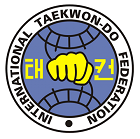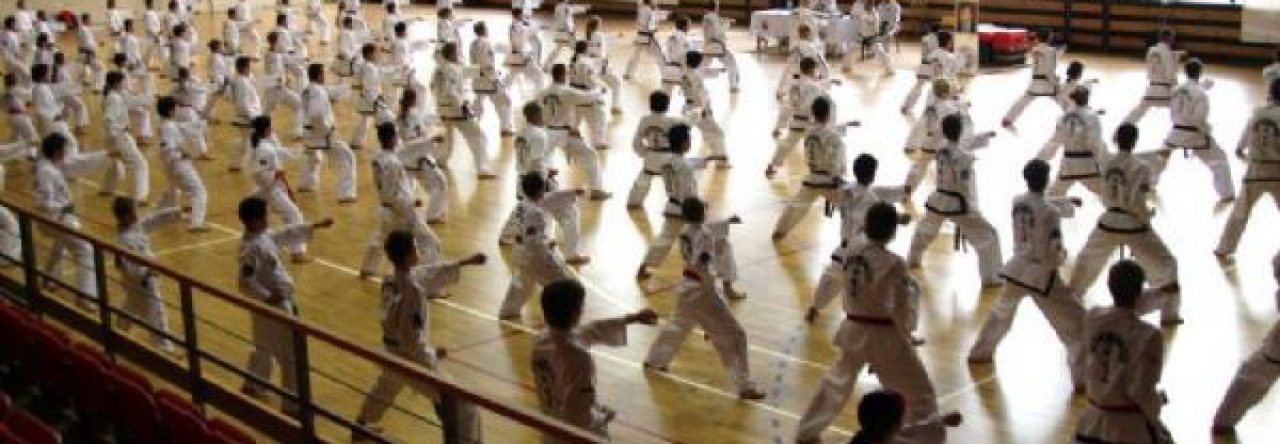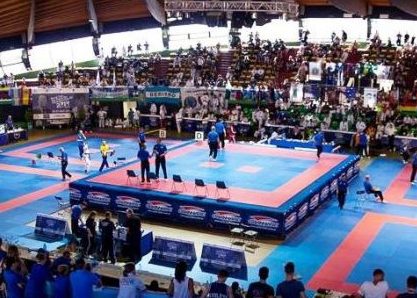ITF Umpiring Roles and Responsibilities

National Umpire Course Notes
SPARRING
These are some recommended ITF Umpiring guidelines used in planning and holding domestic competitions, based on the ITF Tournament Rules.
Note : The ‘Official’ ITF Rules are only applicable to ITF World Championships, and as such much of it is not relevant to in-house, local, state and national level competitions.
A National Organization, or any competition for that matter, should adopt rules that are specific to:
- the event/s being conducted.
- the ages of participants
- the experience levels of participants
- the objective of the competition
- the facilities being used
- the schedule / time available
- the umpires/officials available
Purpose of the ITF Umpiring Rules
- Clarify responsibilities of officials
- Outline scoring criteria for each event
- Determine eligibility of competitors
- Outline operational procedures of all events
- Assist competitors and coaches in event preparation
- Ensure the safety of all competitors and officials
Characteristics of a good Umpire:
- Be consistent and fair in all judgements
- Base all decisions on the Rules of the competition
- Be assertive and confident in all decisions
- Display Punctuality and work ethic
- Be professional in appearance and behaviour
- Be willing to receive constructive feedback and advice from Tournament Directors
- Have a thorough knowledge of the rules – updated regularly
- Integrity, honesty and strength of character
- Ability to follow instructions
- To be flexible and adaptable in various official roles
- Some appreciation and empathy of the competitor’s task
- Ability to make logical, correct decisions quickly and under pressure
- Do not engage spectators or competitors while judging.
- have a basic knowledge of First Aid
- You must be conversant with all patterns / techniques you are to judge
ITF Umpiring uniform consists of
- a navy blue blazer jacket,
- white, long sleeved shirt,
- navy blue trousers or knee-high skirt
- navy blue tie (with no other colours or decorations- I.T.F. logo permitted)
- white socks
- white gym/Taekwon-do shoes
Alternatively, polo tops may be used where a sponsorship arrangement is in place, or approved by the National Organization.
The Competition area – Sparring
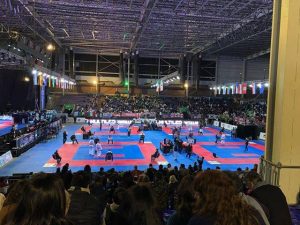
Ring size should be 7m by 7m square of competition space.
- There should be at least a 1m safety perimeter (total matted area min. 9x9m).
- Sparring judges are positioned at each corner.
- The official Jury table is positioned at the front of the ring
- There should be adequate distance between the competition area and spectators for safety and integrity of judging
- Judges should be positioned a safe distance from competition area
Bout Duration
Adults
- Individual elimination and final bouts will be two (2) rounds of two (2) minutes duration with a one (1) minute break between rounds.
- In the event of a draw, an additional round of one (1) minute will be contested.
- In the event of another draw, a ‘first point wins’ scenario will occur, which has no time limit.
- Each team bout will be one (1) round of two (2) minutes.
Bout lengths for younger / older categories are at the discretion of the Tournament Organizers.
Bout Procedure
INDIVIDUAL SPARRING
- Competitors will commence the bout on the start positions
- At the command of the Centre Referee the competitors bow in turn to the Jury table, and then
- to each other.
- The Centre Referee will then start the Sparring with the command “SHI-JAK” and the competitors
- continue to spar until the Referee issues the command “HAECHYO”.
- At this point the competitors cease to spar and remain where they are until restarted.
Central Umpire (Sparring)
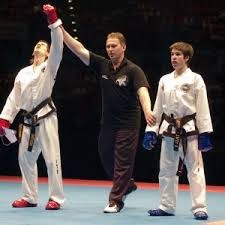
Responsibilities
- Control the procedure of the bout
- Ensure competitors abide by the competition rules
- Allocated penalties where appropriate
- Communicate with Jury President
- Clearly signal all decisions to judges.
Sparring – Referee Terminology
CHARYOT – ATTENTION
KYONG YE – BOW
JUNBI – READY
SIJAK – BEGIN
HAECHYO – SEPARATE
GAESOK – CONTINUE
GOMAN – END
JU UI – WARNING
GAM JUM – DEDUCTING PO1NTS
SIL KYUK – DISQUALIFICATION
HONG – RED
CHONG – BLUE
DONG CHON – TIE
IL BUNYON – FIRST ROUND
YI BUNYON – SECOND ROUND
JUNG JI – TIME STOPPED
SUNG – WINNER
WARNINGS
Warnings will be assigned for the following offences
- attack to an illegal target
- stepping completely out of the ring (both feet)
- falling down, whether intentional or not (this means any part of the body, other than the feet, touching the ground)
- holding/grabbing/pushing
- sweeping
- faking a blow, pretending to be injured to gain an advantage
- intentionally avoiding sparring
- pretending to have scored a point by raising the arm
NB If an athlete is pushed out of the ring with intent (without undergoing a technique) then he will not receive a warning
Note: Any 3 cumulative warnings results in a deduction of 1 point (NOT a foul)
FOULS
A Foul results in 1 Minus point, and will be awarded for
- excessive contact
- loss of temper
- insulting an opponent in any way
- biting/scratching
- attacking with knee/elbow/forehead
- attacking a fallen opponent
- attacking to an illegal target with contact
- excessive or uncontrolled attack
- continuing to attack after Umpire’s command of Haechyo
Corner Judging
Responsibilities:
- To score the bout according to official scoring criteria
- To have a thorough knowledge of technique
- To record and tally scores precisely
- To be consistent and non-biased in scoring
During the bout:
- the Corner Referee must be up to date with all the I.T.F. Tournament Rules
- sit properly and must observe with attention the competitors’ actions record point(s), foul(s) and warning(s)
At the end of the match:
- the Corner Referee must deduct one (1) point from the total score for every three (3) warnings
- deduct one (1) point for each Foul
TARGET AREAS
- Head and neck area at the front and sides but not at the back
- Trunk of the body from neck to navel vertically and from a line drawn from the armpit vertically down to the waist on each side (that is frontal area only excluding the back).
SCORING PROCEDURE
In competition a technique is valid when:
- it is executed correctly
- it is dynamic, that is to say it is delivered with strength, purpose, rapidity and precision
- it is controlled on the target
- contact is made with a legal attacking tool
- contact is made to a legal target area
POINTS AWARDED
One (1) point will be awarded for:
- Hand attack directed to mid or high section.
- Foot attack directed to the mid section
Two (2) points will be awarded for:
- hand attack while in air (both feet must be off the ground) directed to high section,
- jumping or flying kick directed to mid section
- Foot attack directed to high section,
Three (3) points will be awarded for:
- jumping or flying kick directed to high section
What to score:
- A single precise blow to an open target.
- Score only what you see, not what you think you see or hear
- Do not be influenced by crowd or competitor’s reactions or suggestions
Jury President
Responsibilities
Oversee the procedure of the bout
- Ensure competitors abide by the competition rules
- Communicate with Tournament Organizing Committee
- Monitor performance of judges and referees – provide feedback
- Scrutinize score sheets and then announce results to Centre Umpire
- Consult with the Tournament director in regards any appeals
DISQUALIFICATION
- misconduct against officials or ignoring instructions
- any behaviour deemed to be unsporting, offensive, or not in the spirit of fair competition
- heavy contact
- committing any 3 fouls
- any competitor suspected of being under influence of alcoholic beverages or drugs
INJURY
- all competitions MUST have a designated and qualified First Aid officer
- when a competitor is injured, the Centre Referee must stop the match and call for First Aid. (The injury to be diagnosed, treated and the Medic to decide about the match continuation)
- when a competitor cannot fight on because of the Medic’s decision:
- he/she is the winner if his opponent is responsible
- he/she is the loser if his opponent is not responsible
- an injured competitor that is unfit to fight, according to the Medic’s decision, cannot fight again during the event
- a competitor that refuses to accept the Medic’s decision will be disqualified
- if two competitors injure themselves at the same time and both are unfit to fight, according to the Medic’s decision, the winner is the contender that has more scored points at that moment. If the competitors are even the Jury President will decide about the bout
Active Participants in this course will be issued a C-Class ITF Umpire Certificate.
This level is issued by the National Organization.
Importantly, regardless of your certified level, you must possess the skills and confidence to effectively control and officiate ITF competitive matches in all events
written by Master Michael Muleta, 8th Degree
ITF Umpire Committee Member 2002-2014
Awarded ‘Outstanding Umpire, 2007 ITF World Championships‘
President & Technical Director, United ITF Taekwon-Do Australia
